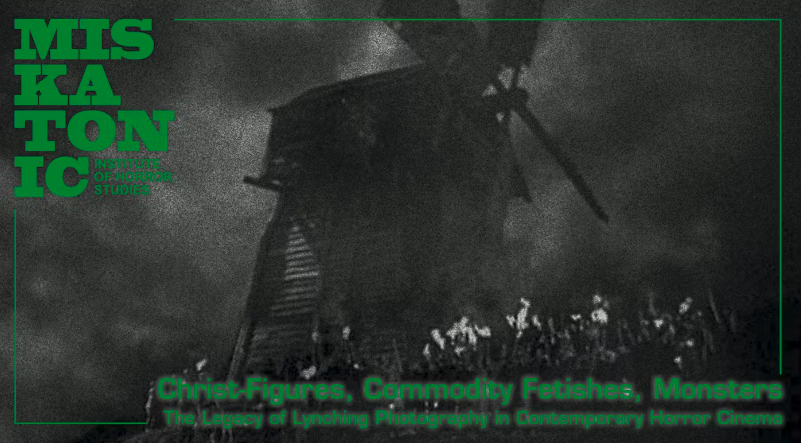Christ-Figures, Commodity Fetishes, Monsters: The Disturbing Legacy of Lynching Photography in Contemporary Horror Cinema brought to you by The Miskatonic Institute of Horror Studies
Doors: 7pm. The talk will begin at 7:15. Please don’t be late.
The practice of lynching was an amalgamation of violences not limited to the physical. Alongside the torture and murder of victims, lynchings also enacted a spectacular performance of white supremacism for its predominantly white audiences. The links between the captive thrill of the lynching scene, at which viewers would stare whilst enjoying their picnics, and the screen violence of horror cinema, in which bodies are also burned, whipped, and torn asunder for the entertainment of (often snacking) tantalized onlookers, has been made by historians and film scholars alike, with W. Scott Poole (2011, p.84) noting that ‘Public executions filmed for public enjoyment functioned as the first horror films.’
This connection between lynching and cinema is compounded by the history of lynching photography and memorabilia, in which not only recorded images but physical artefacts taken from lynched bodies (including parts of the body itself) were bought and sold as part of an ancillary economy in which the suffering of lynching victims was commodified and capitalized. These souvenir items, which fetishize particular identities as well as the scenes and settings in which they are lynched, can be seen to prefigure the celebrity, prop, and merchandise economies of classic and contemporary cinema, in which key costume pieces, set photographs, and commercialized referents to actors and scenes circulate outside of the cinematic space as purchasable signifiers of on-screen action.
Early cinematic references to this ancillary economy, as well as to the act of lynching itself, are present in both D. W. Griffiths’s Birth of a Nation (1915) and James Whale’s Frankenstein (1931), films that clash in terms of genre, tone, acceptability, budget, audience, and cinematography, but are united by a shared focus on violence, shock factor, and ultimately, horror. In light of this historical, economic, and artistic overlap, the lecture aims to trace the cultural legacy of lynching, lynching photography, and lynching memorabilia from Griffiths’s and Whale’s films through to the contemporary horror of the twenty-first-century in order to highlight the continued presence of lynching in contemporary visual culture and the ways in which anti-black violence and racism remains at the centre of popular portrayals of othering and monstrosity.
Presented by Amy Bride
This will not give you access to any online events. You will require a different ticket for that. These events are in-person only, and are not live streamed - sorry.

